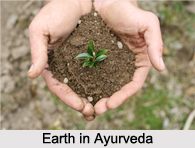 One of the most solid of all the major elements of the nature is Earth or "Prithvi". This element is actually the last one to emerge. The dominance of earth in Ayurveda actually governs the stage of evolution of the body. It is also stated in Ayurveda that any particle or substance with a shape, no matter what its size is, indicates the presence of earth or more commonly Prithvi Bhuta. Prithvi determines all structure, whether in an atom or in molecule, a planet, mountain, a galaxy, a solar system or even in a rock, etc. This principle element governs the shape and the structure of every leaf, branch and flower of the plant kingdom and in the animal kingdom it governs every organ, muscle and bones.
One of the most solid of all the major elements of the nature is Earth or "Prithvi". This element is actually the last one to emerge. The dominance of earth in Ayurveda actually governs the stage of evolution of the body. It is also stated in Ayurveda that any particle or substance with a shape, no matter what its size is, indicates the presence of earth or more commonly Prithvi Bhuta. Prithvi determines all structure, whether in an atom or in molecule, a planet, mountain, a galaxy, a solar system or even in a rock, etc. This principle element governs the shape and the structure of every leaf, branch and flower of the plant kingdom and in the animal kingdom it governs every organ, muscle and bones.
Sense of Smell in Ayurveda
Earth or Prithvi Bhuta is closely associated with sense of smell. It is stated in Ayurveda that whenever Vayu"s drying influence removes the cohesion supplied to a substance by water, nothing keeps the particles of matter in that substance bound together, regardless of state of the substance, it doesn"t matter whether it is a solid, semi-solid, gas or liquid. Such tiny particles start to separate out from the substance and it is the Vayu that disperses them in all directions. These particles eventually come in contact with the organ of smell or the nose. Dry objects have stronger smell as compared to any substance that is abundant with water.
It is the sense of smell that gives information about any particular object without having to see its mass or shape. In the absence of detectable smell, the presence of Prithvi can be determined by the shape or hardness of things. Just like the other elements, Prithvi or earth serves a very protective function by creating prevention from taking anything harmful. Generally, people are attracted to all types of fresh and sweet smells and are repulsed by any type of stale odours. Ayurveda identifies that smells or odours just like tastes have a predictable effect on the balance of the elements of the universe. It is the structure of the sense organs that reflects the quality of the element from which it arises. The sense organ of smell that is the nose has a very hard composition. This sense organ shows the tendency of earth or Prithvi for form and mass.
Ayurvedic physicians use the sense of smell or nose to determine the condition of the bhutas and they detect and discriminate among the odours that are connected with certain specific disease processes. Ayurveda defines that whenever some odour is detected, earth or Prithvi Bhuta is there.




















